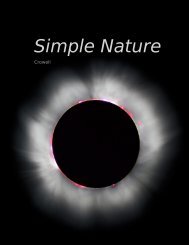The size of a radio antenna is closely related to ... - Light and Matter
The size of a radio antenna is closely related to ... - Light and Matter
The size of a radio antenna is closely related to ... - Light and Matter
Create successful ePaper yourself
Turn your PDF publications into a flip-book with our unique Google optimized e-Paper software.
c / New<strong>to</strong>n’s laws do not d<strong>is</strong>tingu<strong>is</strong>h<br />
past from future. <strong>The</strong><br />
football could travel in either<br />
direction while obeying New<strong>to</strong>n’s<br />
laws.<br />
d / All three clocks are moving<br />
<strong>to</strong> the east. Even though the<br />
west-going plane <strong>is</strong> moving <strong>to</strong> the<br />
west relative <strong>to</strong> the air, the air<br />
<strong>is</strong> moving <strong>to</strong> the east due <strong>to</strong> the<br />
earth’s rotation.<br />
th<strong>is</strong> kind <strong>of</strong> orderly relationship between cause <strong>and</strong> effect <strong>is</strong> said <strong>to</strong><br />
sat<strong>is</strong>fy causality.<br />
Causality <strong>is</strong> like a water-hungry front-yard lawn in Los Angeles:<br />
we know we want it, but it’s not easy <strong>to</strong> explain why. Even in plain<br />
old New<strong>to</strong>nian physics, there <strong>is</strong> no clear d<strong>is</strong>tinction between past<br />
<strong>and</strong> future. In figure c, number 18 throws the football <strong>to</strong> number<br />
25, <strong>and</strong> the ball obeys New<strong>to</strong>n’s laws <strong>of</strong> motion. If we <strong>to</strong>ok a video<br />
<strong>of</strong> the pass <strong>and</strong> played it backward, we would see the ball flying from<br />
25 <strong>to</strong> 18, <strong>and</strong> New<strong>to</strong>n’s laws would still be sat<strong>is</strong>fied. Nevertheless,<br />
we have a strong psychological impression that there <strong>is</strong> a forward<br />
arrow <strong>of</strong> time. I can remember what the s<strong>to</strong>ck market did last year,<br />
but I can’t remember what it will do next year. Joan <strong>of</strong> Arc’s military<br />
vic<strong>to</strong>ries against Engl<strong>and</strong> caused the Engl<strong>is</strong>h <strong>to</strong> burn her at<br />
the stake; it’s hard <strong>to</strong> accept that New<strong>to</strong>n’s laws provide an equally<br />
good description <strong>of</strong> a process in which her execution in 1431 caused<br />
her <strong>to</strong> win a battle in 1429. <strong>The</strong>re <strong>is</strong> no consensus at th<strong>is</strong> point<br />
among physic<strong>is</strong>ts on the origin <strong>and</strong> significance <strong>of</strong> time’s arrow, <strong>and</strong><br />
for our present purposes we don’t need <strong>to</strong> solve th<strong>is</strong> mystery. Instead,<br />
we merely note the empirical fact that, regardless <strong>of</strong> what<br />
causality really means <strong>and</strong> where it really comes from, its behavior<br />
<strong>is</strong> cons<strong>is</strong>tent. Specifically, experiments show that if an observer in a<br />
certain frame <strong>of</strong> reference observes that event A causes event B, then<br />
observers in other frames agree that A causes B, not the other way<br />
around. Th<strong>is</strong> <strong>is</strong> merely a generalization about a large body <strong>of</strong> experimental<br />
results, not a logically necessary assumption. If Keating<br />
had gone around the world <strong>and</strong> arrived back in Washing<strong>to</strong>n before<br />
he left, it would have d<strong>is</strong>proved th<strong>is</strong> statement about causality.<br />
7.1.3 Time d<strong>is</strong><strong>to</strong>rtion ar<strong>is</strong>ing from motion <strong>and</strong> gravity<br />
Hafele <strong>and</strong> Keating were testing specific quantitative predictions<br />
<strong>of</strong> relativity, <strong>and</strong> they verified them <strong>to</strong> within their experiment’s<br />
error bars. Let’s work backward instead, <strong>and</strong> inspect the empirical<br />
results for clues as <strong>to</strong> how time works.<br />
<strong>The</strong> two traveling clocks experienced effects in opposite directions,<br />
<strong>and</strong> th<strong>is</strong> suggests that the rate at which time flows depends<br />
on the motion <strong>of</strong> the observer. <strong>The</strong> east-going clock was moving in<br />
the same direction as the earth’s rotation, so its velocity relative <strong>to</strong><br />
the earth’s center was greater than that <strong>of</strong> the clock that remained<br />
in Washing<strong>to</strong>n, while the west-going clock’s velocity was correspondingly<br />
reduced. <strong>The</strong> fact that the east-going clock fell behind, <strong>and</strong><br />
the west-going one got ahead, shows that the effect <strong>of</strong> motion <strong>is</strong> <strong>to</strong><br />
make time go more slowly. Th<strong>is</strong> effect <strong>of</strong> motion on time was predicted<br />
by Einstein in h<strong>is</strong> original 1905 paper on relativity, written<br />
when he was 26.<br />
If th<strong>is</strong> had been the only effect in the Hafele-Keating experiment,<br />
then we would have expected <strong>to</strong> see effects on the two flying clocks<br />
that were equal in <strong>size</strong>. Making up some simple numbers <strong>to</strong> keep the<br />
382 Chapter 7 Relativity














